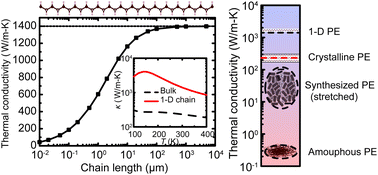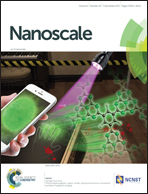Phonon coupling and transport in individual polyethylene chains: a comparison study with the bulk crystal†
Abstract
Using the first-principles-based anharmonic lattice dynamics, we calculate the thermal conductivities (κ) of both bulk and single-chain polyethylene (PE) and characterize the mode-wise phonon transport and scattering channels. A significantly higher room-temperature axial thermal conductivity in single-chain PE (1400 W m−1 K−1) is observed compared to bulk PE crystals (237 W m−1 K−1). The reduction of scattering phase space caused by the diminished inter-chain van der Waals interactions explains the much larger κ in single-chain PE. Different from many previous studies, the thermal conductivity of single-chain PE is predicted to converge at a chain length of ∼1 mm at 300 K. The convergence is explained by the indirect thermal resistance from momentum-conserving scatterings of long-wavelength phonons. It is also found that longitudinal phonon modes dominate the thermal transport in PE chains, while transverse phonon branches with quadratic dispersions contribute little to κ due to their vanishing group velocities and limited lifetimes in the long wavelength limit. The predicted high κ of bulk crystalline and single-chain PE show great potential for use of polymers in thermal management, and the unveiled phonon transport mechanisms offer guides for their molecule-level design.



 Please wait while we load your content...
Please wait while we load your content...